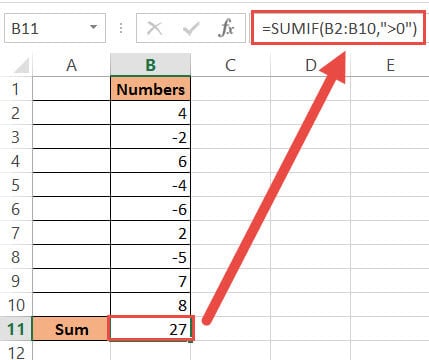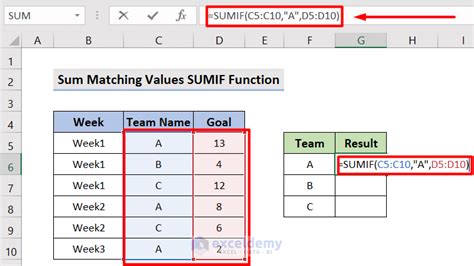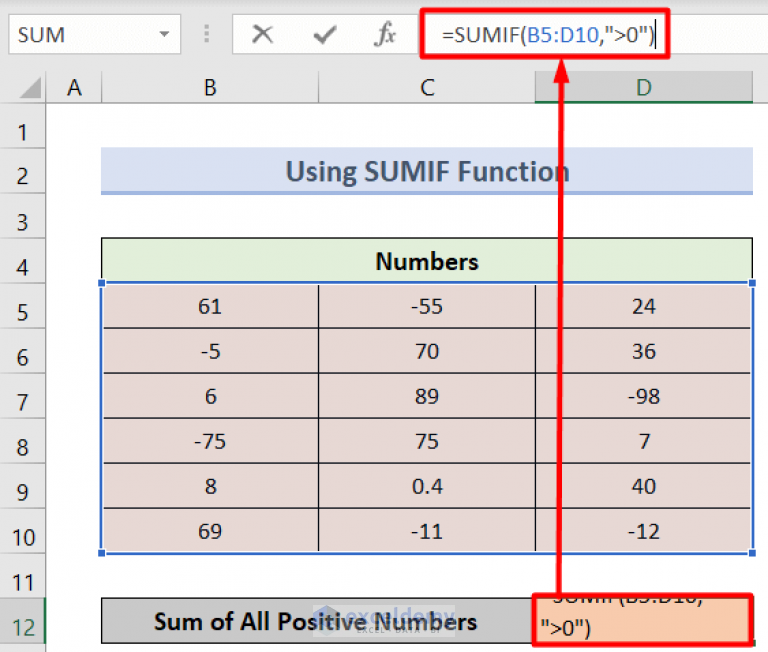2 Ways to Sum Positive Numbers in Excel

2 Ways to Sum Positive Numbers in Excel: A Comprehensive Guide

Excel is a powerful tool for data analysis and manipulation, offering a plethora of functions and features to streamline your work. One common task is summing positive numbers, a fundamental operation with various applications in finance, statistics, and everyday calculations. In this article, we'll delve into two effective methods for summing positive numbers in Excel, providing you with the expertise to tackle such tasks with efficiency and precision.
Method 1: Utilizing the SUM Function

The SUM function is a versatile and widely-used tool in Excel, capable of handling a range of data types and operations. When it comes to summing positive numbers, this function is your go-to choice. Here's a step-by-step guide to harnessing the power of the SUM function for your positive number calculations.
Step 1: Identify Your Data Range
The first step in using the SUM function is to determine the range of cells containing your positive numbers. This could be a single column, a row, or even a non-contiguous selection of cells. For instance, let's assume you have a list of positive numbers in cells A1 to A10.
Step 2: Insert the SUM Function
With your data range identified, it's time to insert the SUM function. You can do this in two ways: manually typing the function or using the Excel function wizard.
Manually typing the function is straightforward. Simply click on the cell where you want the sum to appear (e.g., B1), type =SUM(, and then select the range of cells containing your positive numbers (e.g., A1:A10). Finish the function by typing ) and pressing Enter. Your result, the sum of all positive numbers in the specified range, will appear in the chosen cell.
Alternatively, you can use the Excel function wizard. Click on the cell where you want the sum to appear, navigate to the Formulas tab, click on the AutoSum button, and select the desired range of cells. Excel will automatically insert the SUM function for you.
Step 3: Adjusting for Non-Contiguous Selections
If your positive numbers are scattered across different cells or ranges, you can still use the SUM function. Simply separate each range with a comma when typing the function. For example, if you have positive numbers in cells A1, C5, and E7, your function would look like this: =SUM(A1,C5,E7).
Step 4: Handling Negative Numbers
By default, the SUM function will include any negative numbers in your selected range, which might not be desirable when you're specifically looking to sum positive numbers. To exclude negative numbers, you can employ a simple trick. Multiply your data range by a criterion that checks for positivity. For instance, the function =SUM(A1:A10>0) will sum only the positive numbers in the range A1 to A10.
Method 2: The SUMIF Function for Selective Summing
While the SUM function is powerful, it sums all numbers in a given range. What if you only want to sum positive numbers, ignoring any negative or zero values? This is where the SUMIF function comes into play. It allows you to specify a criterion for summing, ensuring that only positive numbers are included in the final calculation.
Step 1: Understanding the SUMIF Function
The SUMIF function is designed to sum values based on a specified criterion. It takes three arguments: the range of cells to be evaluated, the criterion for summing, and the range of cells containing the values to be summed. In our case, the criterion will be to check for positive numbers.
Step 2: Using SUMIF for Positive Number Summation
To use the SUMIF function for summing positive numbers, you'll need to specify the range of cells containing your data and the criterion for positivity. Here's how you can do it:
First, click on the cell where you want the sum to appear. Then, type =SUMIF( and select the range of cells containing your data (e.g., A1:A10). After the comma, type >0 to specify the criterion for positivity. Finally, enter a closing parenthesis and press Enter. Your result, the sum of all positive numbers in the specified range, will be displayed in the chosen cell.
Step 3: Handling Non-Contiguous Selections
Just like with the SUM function, you can handle non-contiguous selections using the SUMIF function. Simply separate each range with a comma when typing the function. For instance, if you have positive numbers in cells A1, C5, and E7, your function would look like this: =SUMIF(A1,C5,E7,>0).
Step 4: Additional Criteria and Complex Conditions
The SUMIF function's true power lies in its ability to handle complex conditions and additional criteria. For instance, you can sum positive numbers that are greater than a certain value or that meet specific text criteria. To do this, simply adjust the criterion argument in the function. For example, to sum positive numbers greater than 100, you would use =SUMIF(A1:A10,>100).
Conclusion: Choosing the Right Method
Both the SUM and SUMIF functions are powerful tools for summing positive numbers in Excel. The choice between them depends on your specific needs. If you simply want to sum a range of positive numbers, the SUM function is quick and efficient. However, if you need more control over which numbers are included in the sum, the SUMIF function is your best bet.
Remember, Excel is a versatile tool, and there are often multiple ways to achieve the same result. Experiment with these functions, and don't be afraid to explore Excel's extensive library of functions to find the best solution for your data analysis tasks.
Can I use these functions for negative numbers or zeroes as well?
+Absolutely! You can modify the criteria in the SUMIF function to include negative numbers or zeroes. For example, =SUMIF(A1:A10,<=0) will sum all negative numbers and zeroes in the specified range.
Are there any limitations to the number of cells I can sum using these functions?
+Excel has a limit on the number of cells you can reference in a formula, which is currently 255 for the SUM function and 2048 for the SUMIF function. However, this is a very large number, and you’re unlikely to encounter this limit in most practical scenarios.
Can I sum positive numbers across multiple worksheets or workbooks using these functions?
+Yes, you can! You can specify the range of cells to be summed using absolute cell references (e.g., A1) or by referring to other worksheets or workbooks using their names (e.g., [Book1.xlsx]Sheet1!A1:A10). This allows you to perform calculations across multiple sheets and even different workbooks.


